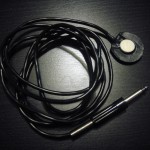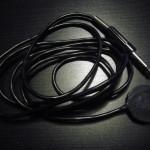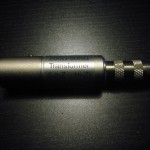INTRODUCTION
Today I am going to explore the world of contact microphones. Contact microphones are different from normal traditional microphones since they are designed to sense sound vibrations through solid objects. One of the most famous uses of a contact mic was done by sound designer Ben Burtt when he attached one of them to a metal wire and then hit the wire with a hammer. The resulting sound was used as the laser blast sound in the Star Wars movies. In this review I am going to take a closer look at the C-series contact microphone handmade by Jez Riley French.
FACT BOX:
I could not find the basic technical specifications for this microphone but here is a list of features that Jez mentions on his website:
– High spec, low noise, flexible specially designed cable
– Large diameter element providing, in conjunction with the JrF exclusive ‘acoustic-transfer’ coating, an even stronger signal
– Strengthened top of element for increased placement and handling durability
– Available with ¼-inch jacks only (Rean/Neutrik)
WHERE TO BUY:
Jez Riley French website
Price:
£35 (uk) / £40 (rest of world)
FIRST IMPRESSIONS
I was browsing the internet for contact microphone related info and somehow found my way to JrF’s website. I listened to the C-series contact microphone sound examples on the site and even noticed that BBC sound recordist Chris Watson had used them to record centipede footsteps. Now that is quite an endorsement! I pretty much decided to buy a stereo pair of these on the spot and that set me back around £80 / 100 euros. I also decided to buy a pair of impedance transforming adapters from JrF because I had read the great contact microphone blog post by Tim Prebble who wrote that contact microphones are all about impedance. A pair of these impedance adapters cost me £44 / 55 euros. So the total cost of both the microphones and the adapters was around £125 / 155 euros.
The build quality of the microphones is good considering the price tag. One microphone weighs very little so you can easily take a pair with you on the road. The microphone comes with a 2-meter cable which only has a ¼-inch jack connector. This is where the impedance adapters come in since they allow the microphone to be connected to a normal 3-pin XLR input. The adapters also provide strong impedance so you can get the full sound of the microphone through. One thing that I want to point out is that the microphones did not arrive with a carrying case. Fortunately I found a cheap and compact case from Thomann which protects the microphones when I carry them on the road.
ON THE ROAD
The first thing I recorded was a cordless hair clipper. I decided to experiment and try to place the clipper against a metal drying rack. I attached one of the contact microphones to the body of the rack with regular adhesive tape, started the clipper and began recording. At this point I didn’t know the hair clipper was almost out of power so I was pleasantly surprised that recording was on when it finally died out. Here is the recorded result of that event.
The first test was a success and I was hooked. I was also quite impressed by the sound quality and the low noise floor of this little microphone. I immediately wanted to test it out more and especially both mics together as a stereo pair. I decided to record the metal kitchen sink so I attached the microphones underneath the sink with tape and then filled it with water. I started to record short water gurgles by opening the faucet in short bursts and I was blown away by the result! The recording had nice deep bass frequencies mixed with the surprisingly clear water gurgles. Here is the edited version of the original recording accompanied with a pitched down version as well.
A work colleague brought his 3D printer to work and of course I asked to record it after work hours. I wanted to hear what the X and Y-axis motors sounded like with contact microphones attached to them. This time I decided to use blu-tack to attach the microphones to the motors since there was not enough space to use tape. I did some test recordings and noticed that the sound was “off” somehow so I checked the microphones and they were okay. After a while I decided to use less blu-tack so I could get a good stable contact with the motors. This seemed to work nicely and off I went to record an hour and a half of rich full sounding mechanical motor sounds. Here is a brief edited sample of the 3D printer recording session.
Next I wanted to try to record some of the noises a human body makes. The most obvious thing to record with these microphones was my heartbeat so I set up my Sound Devices 702 and took the microphones in my hands and pressed them on my chest close to my heart. I quickly noticed that you have to be really stable and not press the microphones too hard when using your hands as the microphone stands. When I pressed the microphones too hard I noticed the pressure added some unwanted rumble caused by the tension in my hands. So I pressed the microphones lightly and held my hands as steady as I could. The result was this really deep and pleasing heartbeat sound.
Last but not least: I recorded some nasty stomach rumble sounds while having a stomach flu. At first I had some difficulties of locating the best source for the sounds but soon I found a good spot for the microphone on my stomach. Again I encountered the handling noise issue when holding the microphone in my hand. This is not a fault of the microphone since they are designed to pick up sounds this way but it’s important to bear that in mind when using these. The following sound example is pretty gross but really awesome too so listener discretion is advised!
VERDICT
I am very impressed by the JrF C-series contact microphone. For a small price you will get a good sounding microphone with a noise-floor low enough to achieve clean recordings. The frequency range of the microphone is also good and will definitely result useful recordings. If you want a contact microphone with even lower noise floor and wider frequency range then you have to shell out much more money. In my opinion the JrF C-series contact microphone has a great price/quality ratio. Just be prepared to buy a carrying case or a bag too if you are planning to take the mic on the road.
- Good sound quality
- Low noise floor
- Easily affordable price
- No carrying case




